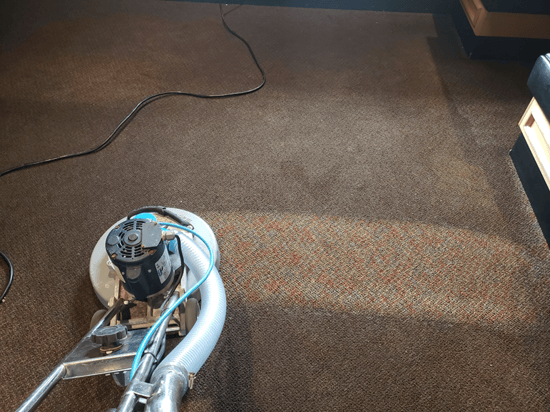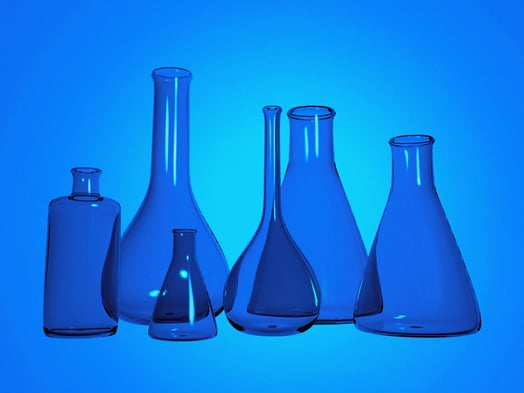Powders naturally have a much longer shelf life than comparable liquids.
A high-alkaline powder is safer to handle than a comparable liquid because the added water makes the chemical hazardous.
A jar of powdered pre-spray (100 percent solids) will make 25 to 50 ready-to-use gallons, while a concentrated liquid pre-spray (30% solids) with equal amounts of solvents, surfactants, and builders will make 16 to 32 ready-to-use gallons of pre-spray.
Most liquid pre-sprays are not that concentrated so powders also save money because the concentration level reduces packaging and shipping costs.

What are The Limits of Science?
The limitations on the type of raw materials in powders and the amount of liquid able they are able to absorb make powders similar to one another.
Alkaline pre-sprays generally have 90 percent alkaline powders and 10 percent liquid divided between solvents and surfactants. This is
the basic anatomy of a powdered pre-spray.
Unique powdered formulas are hard to develop because of the boundaries of science.
There is a limit to the amount of liquid that can be absorbed into powders--10 percent liquid is the general rule.
All powders need to be dissolved into water to become usable cleaners. However, not all powdered raw materials readily dissolve into water, which means that there can be a significant difference in the time necessary to mix products into clear solutions.
Many manufacturers work to make their formulas quickly mixable. Lighter forms of alkaline builders will make some products dissolve at a much faster rate resulting in an uncommon feature.
The Building Blocks of Powdered Formula
A powdered product requires the bulk of the cleaning to be done with builders. The primary alkaline builders used are sodium tripolyphosphate (STPP) and sodium carbonate.
Sodium carbonate costs X, and STPP 4X. Generally, if you do not use STPP in your powdered formula then it will cost a lot less. The higher the pH, the less STPP is used.
Using STPP in a pre-spray significantly increases the free rinsing of the pre-spray and elevates its performance above others that only use water in the extraction cycle.
Secondary builders are added to modify pH. Monosodium phosphate and sodium bicarbonate are used to lower pH, and sodium metasilicate is used to increase pH.
Non-ionic surfactants, solvents, and protease enzymes can be added to boost oil removal characteristics and work well in variable levels of heat and pH.

Creating Unique Properties for Powdered Pre-spray
One way to create exclusivity is to use a special cationic surfactant/hydrotope, which attracts charged particulate soil away from the surface and base of the fiber into the cleaning solution for efficient extraction. This charged particulate soil includes globs of oil and filtration soil.
These blended non-ionic and cationic surfactant pre-sprays have found their place with polyester-type carpets with particulate oily soils. The attraction of charged soils into the cleaning solutions away from the fibers is indeed a unique approach found in only a few select cleaning solutions.
As polyester carpets continue to proliferate into homes these high-performance solutions with a special blend of surfactants will become the standard performance selection by professional cleaners.
Another way to create a difference is to rely on powders with a higher level of absorption of liquids.
Some powders absorb liquids, and others do not.
The percent of liquid that you want to use is determined by the total absorbency of the powders in the formula. Excessive liquid results in the powder “bricking” (Some of this is caking that increases as the product ages).
The selection of highly absorbent powders allows a few special formulas to absorb up to 15% more liquid without texture issues. Five percent more does not seem like much but is 50% more liquid than most powdered formulas.
Whenever you can make something 50% better, you have achieved a noticeable difference in performance.
Conclusion
In short, most powders are created equal, unless you use the best selection of raw materials.
You also need to know a few methods to improve performance by overcoming in some ways the basic anatomy of a powdered chemical formula.
Like what you read? Subscribe to our blog and get free expert advice on how to improve your business
You can also take your education beyond our blogs by attending an industry class:
IICRC Carpet Cleaning Tech Aramsco/ Interlink Supply Training Schedule (cvent.com)
